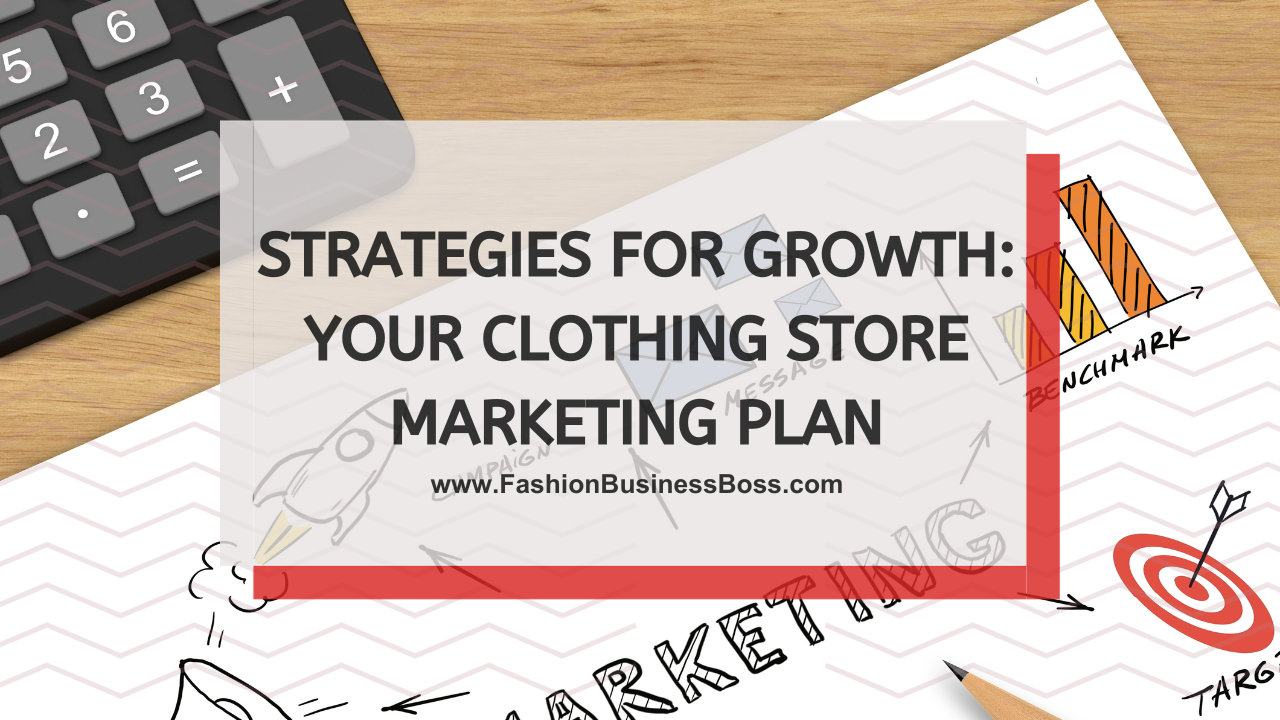A well-thought-out marketing plan is your roadmap to growth. With changing consumer preferences and fierce competition, it’s crucial to have a strategy that not only captures attention but also converts it into loyal customers.
To create a winning clothing store marketing plan, understand your audience, set clear goals, leverage online presence and content, embrace influencer partnerships, and adapt to evolving trends.
In this article, we’ll explore the key components of a clothing store marketing plan that can elevate your brand and drive growth.
Understanding Your Target Audience

Prior to delving into marketing strategies, it’s crucial to gain a profound understanding of your ideal customers. Who comprises this group? What are their basic characteristics, interests, and shopping habits? To address these inquiries effectively, conducting comprehensive market research is imperative. This research forms the foundation upon which your entire marketing plan is constructed.
Market research involves investigating and gathering data about your potential customers. This data typically includes information like age, gender, location, income level, and occupation. It encompasses their interests, preferences, and the factors that influence their purchasing decisions.
By conducting this research, you can create a detailed customer profile. This profile becomes a valuable resource for tailoring your marketing efforts precisely to the wants and needs of your target audience. It guides your decisions regarding product offerings, marketing channels, messaging, and promotional strategies. Ultimately, a deep understanding of your audience allows you to connect with them on a meaningful level, fostering trust and encouraging them to choose your clothing store over competitors.
Read more about: Starting a Clothing Line: The Cost Breakdown
Setting Clear Goals and Objectives
In the realm of effective marketing plans, clarity and measurability are paramount. These plans commence with distinct, quantifiable objectives. What exactly do you aim to achieve? Is it heightened foot traffic to your physical store, amplified online sales, or an enlargement of your customer base? To ensure you are on the right path and can gauge your progress, it is essential to define precise and attainable goals.
When crafting these objectives, make sure they are specific, so there’s no ambiguity in what you’re striving for. They also should be realistic and within reach based on your resources and circumstances. Attainable goals are those that can be accomplished with reasonable effort and strategy.
Setting clear goals and objectives serves as a navigational beacon for your marketing plan. It provides a framework for decision-making and resource allocation, ensuring that your efforts are aligned with your desired outcomes. Moreover, it enables you to track your progress and make adjustments as needed to remain on course toward your defined objectives. This deliberate approach enhances the effectiveness of your marketing plan and bolsters your chances of achieving your desired outcomes.
Creating Your Unique Brand Identity
In the world of clothing stores, establishing a distinctive brand identity is pivotal in setting yourself apart from competitors. This identity encapsulates essential elements like your store’s name, logo, chosen colors, and the overall atmosphere or feeling you wish to convey. It’s a crucial aspect that demands thoughtful consideration.
Begin by selecting a name that not only represents your store but also resonates with your intended audience. Your name should be memorable and easy to recall. Your logo, on the other hand, should visually represent your brand and the values it embodies. It serves as a visual symbol that customers associate with your store.
Colors play an essential role in brand identity, as they evoke specific emotions and associations. Choose colors that align with your brand’s personality and appeal to your target audience. Whether it’s vibrant and energetic or calm and soothing, your chosen color palette should communicate the desired vibe.
Ultimately, your brand identity should mirror the preferences and values of your target audience. It should create a connection and a sense of belonging, making customers feel that your clothing store aligns with their style and aspirations. Building this unique brand identity ensures that your store stands out and leaves a lasting impression in the minds of potential customers.
Building an Online Presence

In today’s digital age, having a robust online presence is non-negotiable for clothing stores. It’s not merely a choice but a necessity.
Firstly, create a user-friendly website. Your website should be easy to navigate and visually appealing, providing visitors with a seamless browsing experience. It’s the foundation of your online presence.
Secondly, optimize your website for search engines (SEO). Enhancing your website’s visibility in search engine results is crucial. Implement SEO techniques to ensure that potential customers can find your website when they search for clothing-related keywords. This includes optimizing your content and meta tags, improving page load times, and acquiring quality backlinks.
Thirdly, leverage social media platforms. Utilize platforms such as Facebook, Instagram, and Twitter to connect with your audience. Post engaging content that showcases your clothing offerings through captivating visuals and informative posts. Interact with your followers by responding to comments and messages promptly.
Lastly, maintain a consistent content schedule. Regularly update your website and social media profiles with fresh content, including new product releases, fashion tips, and behind-the-scenes glimpses of your store.
Read more about: Starting a Clothing Line? These T-Shirts Are Key
Leveraging Content Marketing
In the realm of online marketing, content plays a pivotal role. It’s like the monarch of the digital world. To harness its power effectively, consider the following steps:
First and foremost, develop a content strategy. This strategy should encompass various content types, such as blog posts, videos, and social media updates. The content should revolve around topics like fashion trends, style advice, and product highlights. By creating valuable content, you not only capture the attention of potential customers but also establish your clothing store as a trusted source in the fashion industry.
Blogging is an excellent way to share in-depth insights, fashion tips, and industry knowledge. It not only engages your audience but also improves your website’s search engine ranking. Videos are another potent tool, allowing you to showcase your clothing and provide style guidance. Social media updates keep your audience informed about the latest trends and product releases.
The goal is to offer content that educates, entertains, or inspires your audience. This positions your store as an authority in the fashion world and builds a loyal following. Remember, content marketing is a long-term strategy that fosters a strong connection with your audience over time, ultimately driving interest and sales for your clothing store.
Email Marketing and Customer Retention
Building and nurturing a loyal customer base forms the core of any enduring business. One potent way to achieve this is through email marketing. Here’s how you can go about it:
Begin by implementing email marketing campaigns. These campaigns are designed to keep your customers informed about noteworthy updates like new arrivals, ongoing promotions, and exclusive offers. Through regular emails, you can stay in touch with your audience and maintain their interest.
Personalization is a key aspect of effective email marketing. Address your customers by their names and tailor your email content to their preferences whenever possible. Personalized emails make customers feel valued and appreciated, strengthening their connection with your clothing store.
Furthermore, ensure that your email content is engaging and relevant. Craft compelling subject lines to pique curiosity and encourage opening. The body of the email should provide clear information and visually appealing visuals.
By consistently delivering valuable and personalized content through email marketing, you not only retain your existing customer base but also foster a sense of loyalty. Loyal customers are more likely to return to your store and make repeat purchases, thereby contributing to the sustained growth and prosperity of your clothing business.
Engaging in Influencer Marketing

Incorporating influencer marketing into your strategy can significantly boost your brand’s visibility and credibility. Here’s how to go about it:
Begin by collaborating with fashion influencers. These are individuals who have a substantial following on platforms like Instagram, YouTube, or TikTok, and whose style resonates with your clothing store’s aesthetic. Partnering with influencers allows you to tap into their engaged and loyal audience.
When choosing influencers to work with, consider their alignment with your brand. Look for individuals whose personal style and values align with the image you want to convey for your clothing store. This ensures authenticity in your partnerships.
Once you’ve identified suitable influencers, collaborate with them to promote your products. Influencers can create content, such as photos, videos, or reviews, showcasing your clothing items to their audience. This exposure can introduce your brand to a broader and more targeted audience.
In influencer marketing, authenticity is key. Encourage influencers to provide honest and genuine feedback about your products. Their credibility and trustworthiness can positively impact your clothing store’s reputation and, in turn, drive interest and sales.
Read more about: Starting from Scratch: How to Begin Your Clothing Brand?
Paid Advertising and Promotion
Allocating resources to paid advertising and promotion is a strategic move that can help you reach potential customers effectively. Here’s how you can make the most of it:
Consider investing in targeted online advertising campaigns. These campaigns utilize platforms like Google Ads and social media ads to connect with individuals who are likely interested in your clothing store. This approach ensures that your efforts are directed towards the right audience.
To maximize the impact of your paid advertising, it’s crucial to craft ad copy and visuals that are both engaging and pertinent to your audience. Your ad content should resonate with the interests and preferences of your target customers. The visuals you use, whether images or videos, should be captivating and appealing.
Furthermore, pay attention to the placement of your ads. Choose platforms and channels that align with your audience’s online behavior. For instance, if your target audience spends a significant amount of time on Instagram, consider running ads on that platform.
Regularly assess the performance of your paid advertising campaigns. Monitor key metrics like click-through rates and conversion rates. This data will provide insights into the effectiveness of your ads, allowing you to make adjustments and refine your approach as needed.
Monitoring and Analytics
Keeping a watchful eye on the performance of your marketing endeavors is essential for making informed decisions and improving outcomes. Here’s how to effectively monitor and leverage analytics:
Begin by regularly tracking the performance of your marketing efforts. This involves using analytics tools to collect data on various aspects, including website traffic, conversion rates, and social media engagement. These metrics provide valuable insights into how your marketing strategies are faring.
Website traffic data reveals how many people visit your site, where they come from, and what pages they view. Conversion rates indicate the percentage of visitors who take desired actions, such as making a purchase or signing up for a newsletter. Social media engagement metrics, such as likes, shares, and comments, reflect how your audience interacts with your content.
To optimize your results, analyze this data systematically. Identify trends, patterns, and areas that require improvement. For instance, if you notice that a particular blog post is generating substantial traffic, consider creating more content on similar topics. If your conversion rates are low, investigate potential barriers in the purchase process and make necessary adjustments.
Budget Allocation

Prudent allocation of your marketing budget is pivotal in ensuring you get the most value from your resources. Here’s a straightforward approach to managing your budget:
Begin by wisely distributing your marketing budget across different channels. These channels can include online advertising, content creation, social media, email marketing, and more. Consider the channels that have historically delivered the best return on investment (ROI) for your clothing store.
Prioritizing your budget means assigning more funds to the channels that have proven to be effective in reaching and engaging your target audience. For example, if you’ve found that social media ads generate more leads and sales compared to other channels, you might allocate a larger portion of your budget there.
It’s also crucial to keep a vigilant eye on your spending. Regularly review your budget and expenses to ensure they align with your revenue goals. Staying within your allocated budget helps you maintain financial discipline and avoid overspending.
Read more about: Starting from Scratch: The Essentials for Launching Your Clothing Line
Staying Adaptable
In the fast-paced world of the fashion industry, adaptability is a valuable trait. Here’s how to embrace adaptability as a key aspect of your marketing strategy:
Recognize that the fashion industry is marked by rapid changes in trends, customer preferences, and market dynamics. To thrive, it’s essential to remain flexible and open to new strategies.
Start by continuously assessing your marketing plan. Regularly review its performance, keeping an eye on metrics like website traffic, conversion rates, and customer feedback. This ongoing evaluation helps you identify what’s working and what isn’t.
Be ready to pivot when necessary. If you notice that a particular marketing approach is yielding diminishing returns or if market trends shift, be prepared to adjust your strategy. Adaptation might involve trying new advertising platforms, altering your content strategy, or reevaluating your target audience.
Stay informed about industry trends and consumer behaviors. This knowledge equips you to anticipate changes and proactively adjust your marketing plan to align with evolving circumstances.
Conclusion
A well-crafted marketing plan is the cornerstone of a clothing store. By understanding your audience, setting clear goals, and implementing a multi-faceted strategy that includes online presence, content marketing, email campaigns, influencer partnerships, and more, you can position your store for growth and long-term growth in the competitive world of fashion retail.
Frequently Asked Questions

Q: What is the purpose of a clothing store marketing plan?
A: A clothing store marketing plan serves as a strategic roadmap to attract customers, increase brand visibility, and ultimately drive sales. It outlines the steps and tactics needed to achieve these objectives.
Q: How do I identify my target audience for a clothing store?
A: Identifying your target audience involves conducting thorough market research. Analyze demographics, interests, and shopping behaviors to create a detailed customer profile. This helps tailor marketing efforts effectively.
Q: Why is an online presence important for a clothing store?
A:An online presence is crucial in the digital age as it expands your reach beyond physical locations. It allows you to showcase products, engage with customers, and tap into the vast online market.
To learn more about starting your own clothing business, check out my startup documents here.
Please note that the contents of this blog are for informational and entertainment purposes only and should not be construed as legal advice. Any action taken based on the information provided in this blog is solely at your own risk. Additionally, all images used in this blog are generated under the CC0 license of Creative Commons, which means they are free to use for any purpose without attribution.

Meet Shawn Chun: Entrepreneur and Fashion Business Fan.
I’m a happy individual who happens to be an entrepreneur. I have owned several types of businesses in my life from a coffee shop to an import and export business to an online review business plus a few more and now I create online resources for those interested in starting new ventures. It’s demanding work but I love it. I do it for those passionate about their business and their goals. That’s why when I meet a designer or boutique owner at a craft fair, farmers market, retail location or anywhere else I see myself. I know how hard the struggle is to retain clients, find good employees and keep the business growing all while trying to stay competitive.
That’s why I created Fashion Business Boss: I want to help fashion business owners like you build a thriving business that brings you endless joy and supports your ideal lifestyle.

